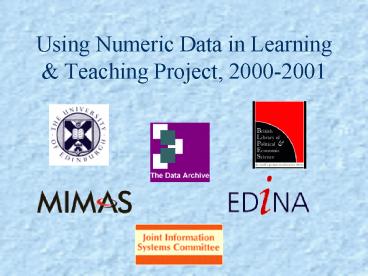Using Numeric Data in Learning PowerPoint PPT Presentation
1 / 20
Title: Using Numeric Data in Learning
1
Using Numeric Data in Learning Teaching
Project, 2000-2001
2
Introduction
- UK is rich in numeric datasets.
- Social Sciences tradition of secondary analysis
ensures use of datasets such as General Household
Survey, Census area statistics, economic time
series, etc. are used in research. - What are the barriers to the use of numeric data
in learning teaching?
3
Project Highlights
- Task Force
- Teachers Survey
- Case Studies
- Open Forum datateach on Jiscmail
- Website http//datalib.ed.ac.uk/projects/datateac
h.html
4
Teachers Survey
- Sample survey of teaching departments, within
Social Sciences plus other empirical subjects. - 250 department heads targeted (1 in 6 sample).
Asked to respond pass to relevant teaching
staff. - Vigorous follow-up by phone email to improve
response rate, make results more representative. - 206 responses from 110 departments in 80
institutions. (Response Rate44).
5
Responding Institutions
Dots in London and other places may represent
more than one institution.
6
Department Types in Sample
- Inside Social Sciences
- Anthropology
- Business Management Studies
- Communications
- Economics
- Education
- Environmental Sciences
- International Relations
- Political Science
- Psychology
- Social Studies (including Social Work Social
Policy) - Sociology
- n126
- Outside Social Sciences
- Agriculture
- Archaeology
- Epidemiology
- Geography
- History
- Nursing Ancillary Services
- Public Health
- Statistics
- Town Planning
- n80
7
Selected Survey Findings
Use of numeric data in this class by percent
(n181).
Those who responded tended to be data users.
8
Purpose of use of data in this class (n181,
respondents asked to tick all that apply).
9
Are students expected to work with the data on a
computer (hands-on) as part of their coursework?
Methods and subject courses defined during
analysis, based on course titles.
10
Use of data in independent learning (Do you
recommend the use of data when supervising
students research?)
- Nearly always do - 35
- Often do - 33
- Only occasionally - 21
- Never have and don't plan to - 6
- Haven't yet but would like to - 2
- Statements made need to be backed up with
evidence often of an empirical nature. - Depends on topic, but statistical sources can
contextualise a topic. - Many students are more inclined to qualitative
research. - Not always appropriate insufficiently briefed
on numeric data available.
11
Source of data used in class (counts, n181,
tick all that apply)
12
Survey Findings National Services
All respondents were asked if they have ever used
or considered using national data services (i.e.
The Data Archive, EDINA, MIMAS) to access numeric
data for learning and teaching purposes. An
overwhelming three quarters had not only 25
said yes. There was no significant difference
found based on the experience of the teacher
(number of years teaching course), or whether
they used data in hands-on teaching. However,
methods teachers were somewhat more likely to
have used national data services than subject
teachers.
13
Ranked barriers (8highest) to using national
data services according to users (n47).
There were 3 responses that ranked Other.
14
Survey Findings Support Needs
From whom have respondents ever had support in
obtaining or using data, whether for teaching or
research? (n188)
15
Forms of local support needed (counts, total
respondents162, tick all that apply).
16
How would you categorise the level of support
from your institution? (n176)
17
Case Studies
- Brown Lee Using Census Data in a Computer
Workshop - Bullen Bayes Using the NCDS in
a
Sampling and Surveys Workshop - Drew Griffiths Research Methods
in
Health Care
- Undergraduates, Urban Poverty Planning Class
- Undergraduates, Computing and Mathematical
Sciences class - Undergraduates, Nursing, compulsory unit on
Statistics
18
Case Studies (contd)
- Fielding Arber Secondary Analysis
Statistical Modelling - Morton Boulton Death and Dying in
Early Modern England - Townsend Payne Basic Data Analysis using SPSS
for Windows
- Postgraduates (Msc), Sociology class -compulsory
module - Undergraduates,
- History web-based course
- Undergraduates, Politics, Philosophy and
Economics course, compulsory module
19
Final Stage Recommendations
- 1. A broad initiative is recommended to promote
subject-based statistical literacy for students,
coupled with tangible support for academic
teaching staff (especially for non-methods
courses). - 2. The development of high-quality teaching
materials for major UK datasets must be funded
adequately, in order to provide salience to
subject matter and demonstrate relevant methods
for coursework.
20
Final Stage Recommendations
- 3. The national data services need to improve the
usability of their datasets for learning and
teaching. - 4. A more concerted and co-ordinated promotion of
the national data services could then follow,
which is responsive to user demand. - 5. Universities should develop IT strategies that
include data services and support for staff and
students, and integration of empirical datasets
into learning technologies.

